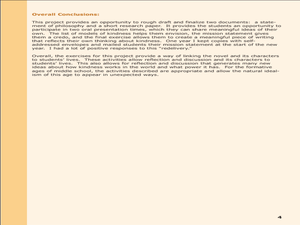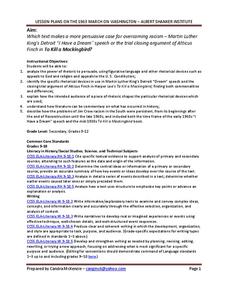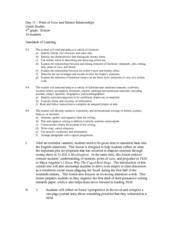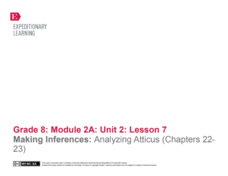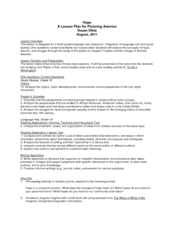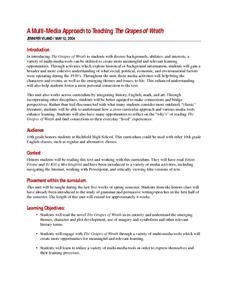EngageNY
Close Reading: Focusing on Taking a Stand (Chapter 2 cont.)
Scholars complete a close read of To Kill a Mockingbird and determine why characters take a stand. They use text-dependent questions and Note-catchers to help guide their thinking. Readers review the Taking a Stand Anchor chart and...
EngageNY
Close Reading: Fishbowl Comparing Atticus and Mr. Gilmer (Chapters 17-19)
Class members participate in two circle group discussions to compare Atticus and Mr. Gilmer in chapters 17-19 of To Kill a Mockingbird. They use a note-catcher to guide their thinking. For homework, readers begin looking at chapters 20-21.
Curated OER
Heroes, Kindness and "To Kill A Mockingbird"
Students read To Kill a Mockingbird and relate the action sof the characters to behaviors in students lives. In this heroism, bullying, kindness and compassion lesson, students identify characters who are heroes in the story. Students...
Curated OER
To Kill a Mockingbird
Students explore the components of racismas they read through Horton Foote's, "To Kill a Mockingbird." The trial of the main character reveals instances of justice in the face of prejudice and forms the focus of the lesson plan.
West Jefferson High School
The Novel — Honor
For classes tackling To Kill a Mockingbird, this lesson plan sets readers up for discussions or essay writing with questions and prompts. The prompts encourage individuals to explore beyond the novel itself, looking at photographs from...
Albert Shanker Institute
Making the Case for Equality: A Comparison
Martin Luther King Jr's " I Have a Dream" speech and Atticus Finch's closing argument during the trial of Tom Robinson both address the societal need to overcome racism. After examining the rhetorical devices and figurative language used...
EngageNY
Writing the First Draft of the Readers Theater Script
Scholars analyze a model Readers Theater script. Then, small groups read their scripts aloud to help determine where they need to make revisions.
Curated OER
Point of View and Mentor Relationships
Tenth graders analyze the role of mentors, point of view, and prejudice using the texts of To Kill a Mockingbird and Maya Angelou's I Know Why the Caged Bird Sings. In this literature analysis lesson, 10th graders review Scout's...
Curated OER
Native Son
For this Native Son worksheet, students read a one page passage from the book and then explain how the extract related to To Kill a Mockingbird. Students answer in essay form.
EngageNY
Analyzing Word Choice: Atticus’s Closing Speech (Chapters 20-21)
Choose your words carefully. Scholars begin by reading a line of Atticus's closing speech in To Kill A Mockingbird. Readers work independently on their note catchers, then complete a Think-Pair-Share activity with partners. They finish...
My Access
“Banning Books” Lesson Plan
To Kill a Mockingbird, Hunger Games, Brave New World. Welcome to Banned Books Week. As part of a study of censorship and book banning, class members investigate censorship, the purposes of censorship, and First Amendment rights,...
PBS
The History of Book Banning in America
Harry Potter, Are You There God? It's Me, Margaret, To Kill a Mockingbird. Kids view a slide show and then discuss the seven banned books featured in the presentation and the reasons why the books may have been banned.
Reed Novel Studies
Paperboy: Novel Study
Little Man, in Vince Vawter's Paperboy, is a great baseball player, but due to stuttering he'd rather not speak to a soul. Scholars read how Little Man deals with his fears as they use vocabulary words to complete sentences, answer seven...
EngageNY
Making Inferences: Analyzing Atticus (Chapters 22- 23)
What's the verdict? Scholars look closely at the reactions of various characters in To Kill A Mockingbird in the aftermath of the verdict. They circulate the room, responding to a variety of probing questions. Pupils finalize their...
Scholastic
Reading Symbols
Philip Pullman's The Golden Compass serves as the anchor text for a lesson on symbolism. Readers use the provided worksheets to examine the symbols in the novel as well as in the world around them.
Curated OER
To Kill a Mockingbird
Young scholars participate in a layered curriculum unit in order to give them opportunities to master objectives. Students pick the activities and this allows a differentiated instructional activity to occur with many opportunities for...
Curated OER
Picturing America: Images and Words of Hope from Romare Bearden and Langston Hughes
A carefully crafted three-day lesson integrates poetry and visual art. By analyzing and comparing Langston Hughes' poem "Mother and Son" and Romare Bearden's collage "The Dove," readers explore the theme of hope. The lesson activates...
Curated OER
My Ideal World
Students create an image symbolic of their ideal world. In this lesson inspired by To Kill a Mockingbird and the artwork of Edward Hicks, students use Adobe Photoshop to create an image symbolic of their personal utopia.
Curated OER
A Multi-Media Approach to Teaching The Grapes of Wrath
Integrate history, math, and art into a study of The Grapes of Wrath with a series of activities that ask learners to investigate the social, political, economic, and environmental factors at play during the 1930s. Designed to be used...
Perfection Learning
I Know Why the Caged Bird Sings
A revolutionary work of literature requires a revolutionary assessment project. A series of activities on Maya Angelou's I Know Why the Caged Bird Sings includes discussion questions, a plot synopsis, and a selection of both short and...
Curated OER
Exploring Prejudice and Text-to-Text Relationships
Tenth graders use the novel To Kill a Mockingbird to analyze relationships in society. In this literature analysis lesson, 10th graders participate in a shoe activity where they bring in one shoe belonging to someone they know and a...
Curated OER
Design for Social Justice
Students create a solution to a social justice problem within their community. In this urban planning lesson, students read To Kill a Mockingbird by Harper Lee and A Lesson Before Dying by Ernest Gaines. Students then complete a research...
Curated OER
Literature: Mapping the Mockingbird
Young scholars read Harper Lee's To Kill a Mockingbird, focusing on setting. They list items that create mental images of the novel's setting along with location references to characters and events. Using posterboard, they construct...
English is a Piece of Cake
Emotional Intelligence
How would you describe a great leader? Explore the theme of leadership with a unit that focuses on emotional intelligence, and how great leaders have a strong sense of emotional intelligence.




